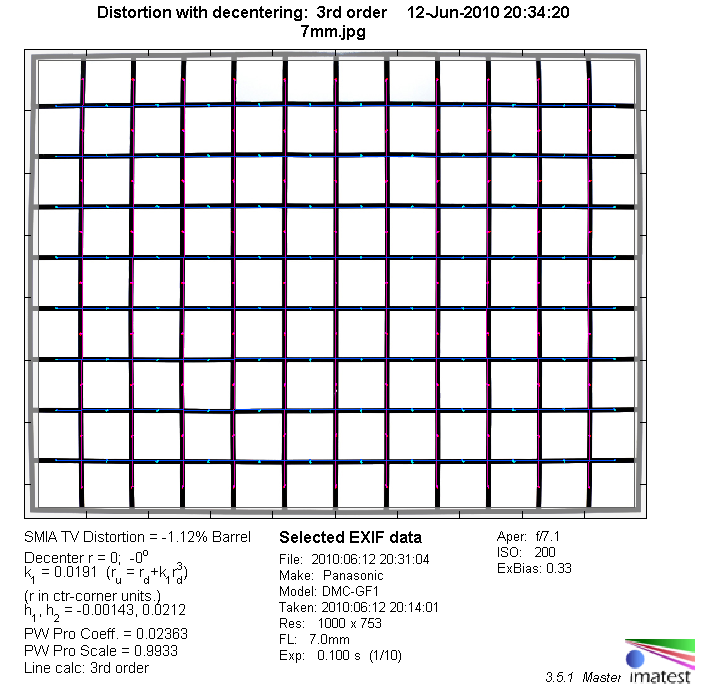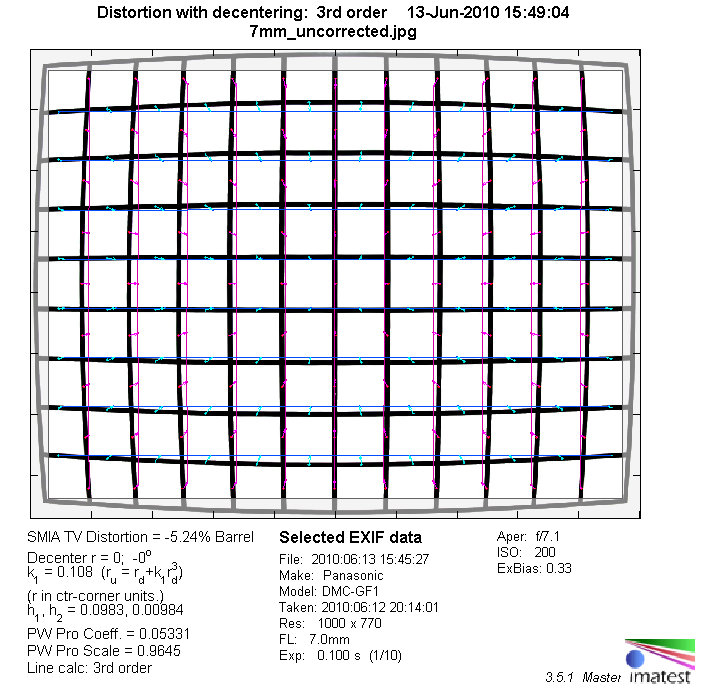|
Panasonic Lumix G 7-14mm f/4 ASPH - Review / Test Report - Analysis |
|
Lens Reviews -
(Micro-)Four-Thirds
|
|
Page 2 of 3

Distortion
The image distortion produced by micro 4/3 images is auto-corrected either directly in the camera (JPEGs) or in most RAW-converters. The "exposed" distortion is therefore very moderate especially for such an ultra-wide zoom lens. They range from a slight (~1.1%) barrel distortion at 7mm to marginal pincushion distortion at 14mm. This is nothing to worry about from a field perspective.
|
Move the mouse cursor over the focal length text marks below to observe the respective distortion
|
| 7mm |
10mm |
14mm |
|

|
However, this is only one part of the truth. The situation changes significantly when working without auto-correction (e.g. via RawTherapee) which gives an insight about the native distortion characteristic. The amount of barrel distortion is indeed very extreme at 7mm (5.2%) altough the problem eases towards the long end of the range.

Vignetting
The Panasonic lens has, surprisingly, the same vignetting characteristic like a convention DSLR lens - it is not auto-corrected other than due to the (substantial) image cropping caused by the distortion correction. There's consequently a very high amount of light fall-off at f/4 (1.1-1.3EV). This will be noticeable in some situations. Stopping down to f/5.6 resolves most of the problem from a field perspective.
MTF (resolution)
The resolution figures of the Lumix lens are pretty impressive for an ultra wide angle zoom lens. The performance is also very uniform along the zoom range. The center performance is excellent at f/4 and f/8 and the borders and corners follow on a very good level. However, at 7-10mm there's a bit of softness in the very last mm of the sensor which is not covered by our tests. Diffraction effects reduces the resolution potential from f/8 onwards.
Please note that four-thirds cameras have a different diffraction characteristic than APS-C or full format cameras. The real-world sweet spot, the point of highest resolution, is generally around f/4, maybe a little less. Therefore it's hardly possible to improve the performance by stopping down when using (such) slow speed lenses. Remember that f/8 on a four-thirds camera is comparable to f/16 on a full format camera so f/5.6 is actually already well sufficient to achieve a maximum amount of depth-of-field at conventional focus distances.
Please note that the MTF results are not directly comparable across the different systems!
Below is a simplified summary of the formal findings. The chart shows line widths per picture height (LW/PH) which can be taken as a measure for sharpness.
If you want to know more about the MTF50 figures you may check out the corresponding Imatest Explanations
Chromatic Aberrations (CAs)
Lateral CAs (color shadows at the image borders) are auto-corrected and as such nothing to worry about.
The situation isn't quite as impressive when analyzing the "native" performance of the lens here. e.g. At 7mm @ f/5.6 we measured an average CA pixel width of around 1.5px. However, even so this is still comparatively well controlled for an ultra-wide zoom lens.
|